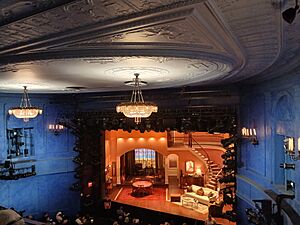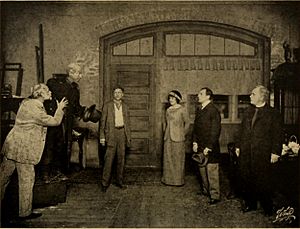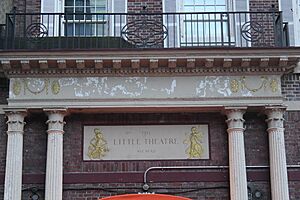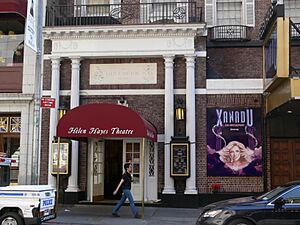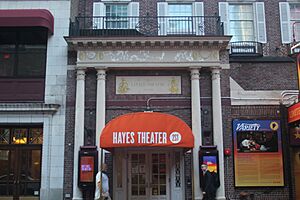Hayes Theater facts for kids
|
Helen Hayes Theatre
Little Theatre New York Times Hall |
|
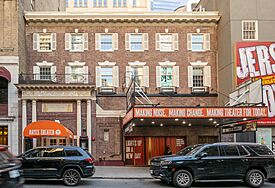 |
|
| Address | 240 West 44th Street Manhattan, New York United States |
|---|---|
| Coordinates | 40°45′28″N 73°59′16″W / 40.7579°N 73.9878°W |
| Owner | Second Stage Theater |
| Type | Broadway |
| Capacity | 597 |
| Production | Purpose |
| Construction | |
| Opened | March 12, 1912 |
| Years active | 1912–1941, 1963–1965, 1974–present |
| Architect | Harry Creighton Ingalls |
| Designated | November 17, 1987 |
| Reference no. | 1346 |
| Designated entity | Facade |
| Designated | November 17, 1987 |
| Reference no. | 1347 |
| Designated entity | Lobby (foyer and emergency-exit space), auditorium interior |
The Hayes Theater is a famous Broadway theater located at 240 West 44th Street in New York City. It has had several names over the years, including the Little Theatre and the Helen Hayes Theatre. It is named after the actress Helen Hayes. The theater is run by Second Stage Theater and is the smallest on Broadway, with only 597 seats.
The theater was built in 1912 for a producer named Winthrop Ames. It was designed to look like a cozy, old-fashioned house. At first, it was very small, with only 299 seats on one level. In 1920, a balcony was added to make more room for people. Over its long history, the building has been used for plays, as a meeting hall, and even as a TV studio.
The outside of the theater, made of red brick, is a New York City landmark. This means it is protected because of its historical importance. The inside is also special, with beautiful decorations. The theater has a sloped orchestra section and one balcony.
Contents
Location and Design
The Hayes Theater is in the heart of Manhattan's Theater District, near Times Square. It's on a block with many other famous theaters, like the St. James Theatre and the Shubert Theatre.
The theater was designed by the architectural firm Ingalls & Hoffman. The goal was to make theatergoers feel like they were guests in a beautiful old home. When it was first built, it was called the Little Theatre because it was so small and cozy.
The Building's Exterior
The outside of the theater is made of red brick and has limestone trim. The main entrance is on the left side, under a large brick arch. The doors are made of wood and are surrounded by decorative columns. Above the entrance, a stone plaque reads "The Little Theatre MCMXII," which means 1912 in Roman numerals.
To the right of the main entrance are four large doors used for emergency exits. The second and third floors have windows with shutters, making the building look like a colonial-era house.
Inside the Theater
The main entrance leads to the box office and a lobby. The lobby is decorated in the Adam style, which is known for its elegant and detailed designs. The ceiling is vaulted, or curved, and has a beautiful chandelier hanging from the center.
Stairs on both sides of the lobby lead up to the balcony level. The walls have decorative patterns with urns and lyres, which are ancient musical instruments.
The Auditorium
The auditorium is where the audience sits. It is the smallest on Broadway, with 597 seats. There is a main floor, called the orchestra, and one balcony. The orchestra floor slopes down toward the stage so everyone can see well.
When the theater first opened, it had only 299 seats on one level. A balcony was added in 1920 to make the theater larger. The walls are decorated with a blue pattern that looks like old tapestries.
The front of the balcony has a railing with beautiful plaster designs. The ceiling is flat but has fancy plasterwork, including an oval panel in the center with figures of cherubs.
History of the Theater
Between 1900 and the 1930s, Times Square became the center of New York's theater world. Many new theaters were built during this time. Winthrop Ames, the man who built the Hayes, wanted to create a small, special theater for new and interesting plays.
The Little Theatre Era
Ames announced his plan to build a 300-seat theater in 1911. He called it the Little Theatre. Because it had fewer than 300 seats, it didn't have to follow certain fire safety rules for larger theaters.
The Little Theatre opened on March 12, 1912. Ames wanted it to be a place for "clever" and "unusual" plays. One of its first big hits was A Pair of Silk Stockings in 1914.
However, the theater was too small to make much money. In 1917, Ames hired architect Herbert J. Krapp to add a balcony. The renovation was finished in 1920, increasing the number of seats. After the expansion, the theater hosted successful plays like Beyond the Horizon and The First Year.
In 1931, The New York Times Company bought the theater. They planned to tear it down but decided to keep it open. For the next ten years, it continued to show plays.
A Conference Hall and TV Studio
In 1941, the theater was turned into a conference center called the New York Times Hall. It was used for speeches, concerts, and meetings.
In 1951, the American Broadcasting Company (ABC) leased the building and turned it into a television studio. Famous shows like The Dick Clark Show and Who Do You Trust? with Johnny Carson were broadcast from there.
The theater returned to showing plays from 1963 to 1965. It was then leased by Westinghouse Broadcasting and became the studio for The Merv Griffin Show. By the early 1970s, the theater was empty. For a short time in 1973, it was used for purposes that other theater owners protested, and it was quickly closed again.
Return to Broadway
The theater reopened for plays in 1974. One of its biggest hits was the play Gemini, which started in 1977 and ran for over four years.
In 1983, the theater was renamed the Helen Hayes Theatre in honor of the famous actress Helen Hayes. The previous theater named for her had been torn down. A major hit during this time was Torch Song Trilogy, which opened in 1982 and ran for three years.
In 1987, the city officially recognized the theater's building and parts of its interior as historic landmarks. This protected it from being changed or torn down.
Recent Decades
Through the 1990s and 2000s, the Helen Hayes Theatre hosted many successful shows. These included the monologue Defending the Caveman (1995), the play The Last Night of Ballyhoo (1997), and the musical Xanadu (2007).
The popular musical Rock of Ages moved to the Hayes in 2011 and played there for almost four years.
Second Stage and Today
In 2015, a nonprofit organization called Second Stage Theater bought the theater. They wanted to make it a home for new plays by living American writers.
Second Stage spent millions of dollars renovating the theater. They added an elevator, new restrooms, and a lounge in the basement. The renovation was also environmentally friendly.
The theater reopened in 2018 with its name shortened to the Hayes Theater. The first show was a revival of the play Lobby Hero. Since then, it has presented many new and exciting plays, including What the Constitution Means to Me (2019), Take Me Out (2022), and Appropriate (2023).
The theater continues to be an important venue on Broadway, known for supporting new voices in American theater.
See also
- List of Broadway theaters
- List of New York City Designated Landmarks in Manhattan from 14th to 59th Streets




